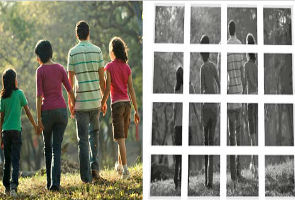- Home
- Social networking
- Social networking News
- Facebook's new way to combat child pornography
Facebook's new way to combat child pornography
By Riva Richmond, New York Times | Updated: 5 June 2012 02:08 IST

Click Here to Add Gadgets360 As A Trusted Source

Advertisement
As online photo sharing has exploded so has, tragically, the distribution of child pornography. But while the rise of the Internet and digital cameras have revived a scourge that had nearly been eliminated in the late 1980s, new technology may also help to beat it back again.
Microsoft says it has refined a technology it created called PhotoDNA to identify the worst of these disturbing images -- even if they are cropped or otherwise altered -- and cull through large amounts of data quickly and accurately enough to police the world's largest online services. And on Thursday, it will announce that Facebook will be the first service to join it in using the free technology, which Microsoft donated to the National Center for Missing & Exploited Children in December 2009.
Facebook, the largest photo-sharing site on the Internet, said it has begun to use PhotoDNA to hunt for several thousand registered illegal images among the 200 million images uploaded by its users each day. Facebook will host an online event at 3:00 p.m. (Eastern time) on Friday to explain the initiative, which follows its January move to join the center's Amber Alert network.
"Our hope and belief is that Facebook will be just the first of many" companies to use what has proven to be highly effective technology, said Ernie Allen, chief executive of the National Center for Missing & Exploited Children. " Online services are going to become a hostile place for child pornographers and pedophiles."
PhotoDNA is being used to find and remove only known images of sexual exploitation of pre-pubescent children to avoid trampling on the privacy and free-speech rights of consumers of adult pornography, he said. The courts have ruled that pornographic pictures of children are child abuse, not legally protected free speech.
By focusing on images of children under 12, the initiative is battling " the worst of the worst" images, which are often shared over and over again, he said. Child pornography is growing increasingly violent and depicting increasingly young children, including infants and toddlers.
"These are crime scene photos," not porn, Mr. Allen said. "This tool is essential to protect these victims and to prevent, to the greatest degree possible, the redistribution of their sexual abuse."
PhotoDNA can currently search for about 10,000 images collected by the National Center for Missing & Exploited Children, which has amassed 48 million images and videos depicting child exploitation since 2002, including 13 million in 2010 alone. The center has a Congressional mandate to act as a clearinghouse for this material, to help identify and aid victims and to assist law enforcement in investigations of perpetrators.
Tests conducted on Microsoft's SkyDrive, Windows Live and Bing services during the last year indicate a chillingly large trade in these images. A network that compares 10 million images to the center's inventory of 10,000 illegal photos can expect to have about 125 hits a day, according to Hany Farid, a Dartmouth computer science professor and expert in digital imagery who worked with Microsoft to hone the technology. At least 50,000 child pornography images are being transmitted online every day, he estimated.
"This is not a tiny dark little world," he said. "The problem is phenomenal."
PhotoDNA works by creating a "hash," or digital code, to represent a given image and find instances of it within large data sets, much as antivirus software does for malicious programs. However, PhotoDNA' s "robust hashes" are able to find images even if they have been altered significantly. Tests on Microsoft properties showed it accurately identifies images 99.7 percent of the time and sets off a false alarm only once in every 2 billion images, and most of them point to nearly identical images, Dr. Farid said.
To create a hash, the software puts the image in black and white and into a standard size. Then it carves the image into blocks and subjects it to an array of measurements. The resulting "signatures" can be provided to online service providers, who can then use them to find these specific illegal images on their systems without possessing them or looking at customers' private content.
"We're very passionate about PhotoDNA because we've seen it work," said Brad Smith, Microsoft' s general counsel. "We invented it through Microsoft research, and we are trying to give it away free, including to our competitors." He encouraged consumers to pressure online services to adopt it.
Until now, Facebook has relied primarily on abuse reports from its users, reviewed by trained employees, to find and eliminate offensive images. But with PhotoDNA, it can keep child pornography from making it onto its site in the first place. "We've found it to be a very powerful tool in identifying these images," Chris Sonderby, Facebook's assistant general counsel said.
PhotoDNA has potential future applications in areas like protecting intellectual property and could aid law enforcement. Rob McKenna, the state attorney general in Washington, said his office is interested in its potential to bolster cases against pedophiles who have molested multiple children by identifying photographs of multiple crimes that occurred in the same physical setting.
Mr. Allen said he hopes that all major Internet services will eventually adopt PhotoDNA, including the 90 technology companies with whom it already works to block and take down Web sites known to trade in child pornography.
The results of the yearlong pilot at Microsoft, he said, should provide "enormous reassurance to companies that this works, that this is something they should do, that it's the responsible thing to do and that they can use it without fear of violating anybody's rights."
Microsoft says it has refined a technology it created called PhotoDNA to identify the worst of these disturbing images -- even if they are cropped or otherwise altered -- and cull through large amounts of data quickly and accurately enough to police the world's largest online services. And on Thursday, it will announce that Facebook will be the first service to join it in using the free technology, which Microsoft donated to the National Center for Missing & Exploited Children in December 2009.
Facebook, the largest photo-sharing site on the Internet, said it has begun to use PhotoDNA to hunt for several thousand registered illegal images among the 200 million images uploaded by its users each day. Facebook will host an online event at 3:00 p.m. (Eastern time) on Friday to explain the initiative, which follows its January move to join the center's Amber Alert network.
"Our hope and belief is that Facebook will be just the first of many" companies to use what has proven to be highly effective technology, said Ernie Allen, chief executive of the National Center for Missing & Exploited Children. " Online services are going to become a hostile place for child pornographers and pedophiles."
PhotoDNA is being used to find and remove only known images of sexual exploitation of pre-pubescent children to avoid trampling on the privacy and free-speech rights of consumers of adult pornography, he said. The courts have ruled that pornographic pictures of children are child abuse, not legally protected free speech.
By focusing on images of children under 12, the initiative is battling " the worst of the worst" images, which are often shared over and over again, he said. Child pornography is growing increasingly violent and depicting increasingly young children, including infants and toddlers.
"These are crime scene photos," not porn, Mr. Allen said. "This tool is essential to protect these victims and to prevent, to the greatest degree possible, the redistribution of their sexual abuse."
PhotoDNA can currently search for about 10,000 images collected by the National Center for Missing & Exploited Children, which has amassed 48 million images and videos depicting child exploitation since 2002, including 13 million in 2010 alone. The center has a Congressional mandate to act as a clearinghouse for this material, to help identify and aid victims and to assist law enforcement in investigations of perpetrators.
Tests conducted on Microsoft's SkyDrive, Windows Live and Bing services during the last year indicate a chillingly large trade in these images. A network that compares 10 million images to the center's inventory of 10,000 illegal photos can expect to have about 125 hits a day, according to Hany Farid, a Dartmouth computer science professor and expert in digital imagery who worked with Microsoft to hone the technology. At least 50,000 child pornography images are being transmitted online every day, he estimated.
"This is not a tiny dark little world," he said. "The problem is phenomenal."
PhotoDNA works by creating a "hash," or digital code, to represent a given image and find instances of it within large data sets, much as antivirus software does for malicious programs. However, PhotoDNA' s "robust hashes" are able to find images even if they have been altered significantly. Tests on Microsoft properties showed it accurately identifies images 99.7 percent of the time and sets off a false alarm only once in every 2 billion images, and most of them point to nearly identical images, Dr. Farid said.
To create a hash, the software puts the image in black and white and into a standard size. Then it carves the image into blocks and subjects it to an array of measurements. The resulting "signatures" can be provided to online service providers, who can then use them to find these specific illegal images on their systems without possessing them or looking at customers' private content.
"We're very passionate about PhotoDNA because we've seen it work," said Brad Smith, Microsoft' s general counsel. "We invented it through Microsoft research, and we are trying to give it away free, including to our competitors." He encouraged consumers to pressure online services to adopt it.
Until now, Facebook has relied primarily on abuse reports from its users, reviewed by trained employees, to find and eliminate offensive images. But with PhotoDNA, it can keep child pornography from making it onto its site in the first place. "We've found it to be a very powerful tool in identifying these images," Chris Sonderby, Facebook's assistant general counsel said.
PhotoDNA has potential future applications in areas like protecting intellectual property and could aid law enforcement. Rob McKenna, the state attorney general in Washington, said his office is interested in its potential to bolster cases against pedophiles who have molested multiple children by identifying photographs of multiple crimes that occurred in the same physical setting.
Mr. Allen said he hopes that all major Internet services will eventually adopt PhotoDNA, including the 90 technology companies with whom it already works to block and take down Web sites known to trade in child pornography.
The results of the yearlong pilot at Microsoft, he said, should provide "enormous reassurance to companies that this works, that this is something they should do, that it's the responsible thing to do and that they can use it without fear of violating anybody's rights."
Comments
Get your daily dose of tech news, reviews, and insights, in under 80 characters on Gadgets 360 Turbo. Connect with fellow tech lovers on our Forum. Follow us on X, Facebook, WhatsApp, Threads and Google News for instant updates. Catch all the action on our YouTube channel.
Related Stories
Popular on Gadgets
- Samsung Galaxy Unpacked 2025
- ChatGPT
- Redmi Note 14 Pro+
- iPhone 16
- Apple Vision Pro
- Oneplus 12
- OnePlus Nord CE 3 Lite 5G
- iPhone 13
- Xiaomi 14 Pro
- Oppo Find N3
- Tecno Spark Go (2023)
- Realme V30
- Best Phones Under 25000
- Samsung Galaxy S24 Series
- Cryptocurrency
- iQoo 12
- Samsung Galaxy S24 Ultra
- Giottus
- Samsung Galaxy Z Flip 5
- Apple 'Scary Fast'
- Housefull 5
- GoPro Hero 12 Black Review
- Invincible Season 2
- JioGlass
- HD Ready TV
- Laptop Under 50000
- Smartwatch Under 10000
- Latest Mobile Phones
- Compare Phones
Latest Gadgets
- Xiaomi 17 Ultra Leica Edition
- Xiaomi 17 Ultra
- Huawei Nova 15
- Huawei Nova 15 Pro
- Huawei Nova 15 Ultra
- OnePlus 15R
- Realme Narzo 90x 5G
- Realme Narzo 90 5G
- Asus ProArt P16
- MacBook Pro 14-inch (M5, 2025)
- OPPO Pad Air 5
- Huawei MatePad 11.5 (2026)
- Huawei Watch 10th Anniversary Edition
- OnePlus Watch Lite
- Acerpure Nitro Z Series 100-inch QLED TV
- Samsung 43 Inch LED Ultra HD (4K) Smart TV (UA43UE81AFULXL)
- Asus ROG Ally
- Nintendo Switch Lite
- Haier 1.6 Ton 5 Star Inverter Split AC (HSU19G-MZAID5BN-INV)
- Haier 1.6 Ton 5 Star Inverter Split AC (HSU19G-MZAIM5BN-INV)
© Copyright Red Pixels Ventures Limited 2025. All rights reserved.

















